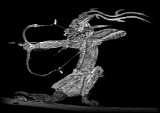
CUTTING HORN FOR BOWS
Adam Karpowicz
Text and photographs ŠAdam Karpowicz, 2002
A pair of water buffalo horns can provide enough material for two, three, or even four bows. Strips of horn are usually sliced off the outer surface of horn, but the inner curve and flat sides can be used for solid strips as well. The leftovers can be made into narrow, side-by-side strips for a Persian bow's belly and small sections can be used for grip inserts or tip reinforcements.
This way the entire horn can be put to good use. For a hobby maker, buying whole horns will be an economical alternative to horn strips, since a hobbyist is not concerned with labour costs. For a commercial maker, pre-cut horn strips may be a better solution to save time.
The horn used for the pictures here was sanded to remove ridges and expose solid material without defects. This step is not essential, since shaping of cut strips can be done later. Also, horn on the pictures was cut in half lengthwise (not normally done), simply because this is all I had available for this exercise. All operations as shown are done with a whole horn in exactly the same way.
Dimensions of strips can vary depending on a style of bow. The outer surface will provide the longest strips. Shorter strips from the second cut can be used for shorter bows - bows with grip inserts or bows with horn ending at siyahs.
Normally, the strips will be cut to yield 6mm thickness of solid horn for about one half of length. The rest of length can taper down to 3mm, or even 2mm to cover the siyahs. After final shaping the thickness of solid horn will be only about 4mm, unless a bow is exceptionally long and heavy. Note horn bows have round bellies, so the outer, round surface does not need to be filed or sanded flat and no material is wasted.
As cut, the first strips will be concave (in cross-section) for most of their length, corresponding to the hollow section of horns. This section can be flattened with heat to yield flat strips. Or, traditionally, the entire strip can be worked into a hollow trough with an adze and scrapers to match the profile of limb core.
Last up-dated March 11, 2002